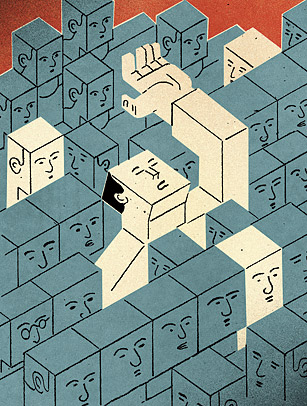
Two competing narratives dominate our debate about the ongoing ethnic and demographic transformation of America. The first holds that non-European immigrants — O.K., let's be honest, Mexicans — will rip apart the nation's social fabric. The second has it that the diversity of younger generations of Americans will inevitably lead to a more integrated, postracial era.
But both of these narratives are off the mark. With some minor differences, today's immigrants are assimilating into U.S. society in ways not terribly unlike those of millions before them. At the same time, it's likely that decades from now, Americans will still invest a lot of meaning in group distinctions.
The most profound changes in American race relations, however, will revolve around the other side of the equation: native-born white Americans. As much as Americans pride themselves on the notion that their national identity is premised on a set of ideals rather than a single race, ethnicity or religion, we all know that for most of our history, white supremacy was the law of the land. In every naturalization act from 1790 to 1952, Congress included language stating that the aspiring citizen should be a "white person." And not surprisingly, despite the extraordinary progress of the past 50 years, the sense of white proprietorship — "this is our country and our culture" — still has not been completely eradicated. Even though we now have an African-American President, we still tend to treat minorities as parts and whites as representatives of the whole. This, along with the luxury of rarely feeling obliged to think self-consciously about one's racial background, has been one of the perks of belonging to the demographic majority.
But according to the Census Bureau, by 2050 whites will be a minority group in the U.S. How the current majority reacts to its incipient minority status is the most crucial sociodemographic issue facing the country in the decade to come.
The most obvious impact will be political. If California's demographic transformation is any indication — Anglos dropped below 50% of the population there in 2000 — whites elsewhere may increasingly develop a stronger consciousness of their political interests as a group. In 1996, California's white voters overwhelmingly supported Proposition 209, a ballot initiative that sought to eliminate state-sponsored affirmative action, because many of those voters felt that the playing field had begun to tilt against them. That decade, California also passed two other ethnically charged ballot measures, against illegal immigration and bilingual education. It's difficult not to conclude that these initiatives were part of a white backlash against the state's ethnic transformation. However, the very demographic trend that inspired those ballot initiatives has ensured that there haven't been any racially charged propositions since. With so-called minorities outnumbering whites, mainstream politicians have been reluctant to endorse any initiative that would invite a backlash from nonwhites.